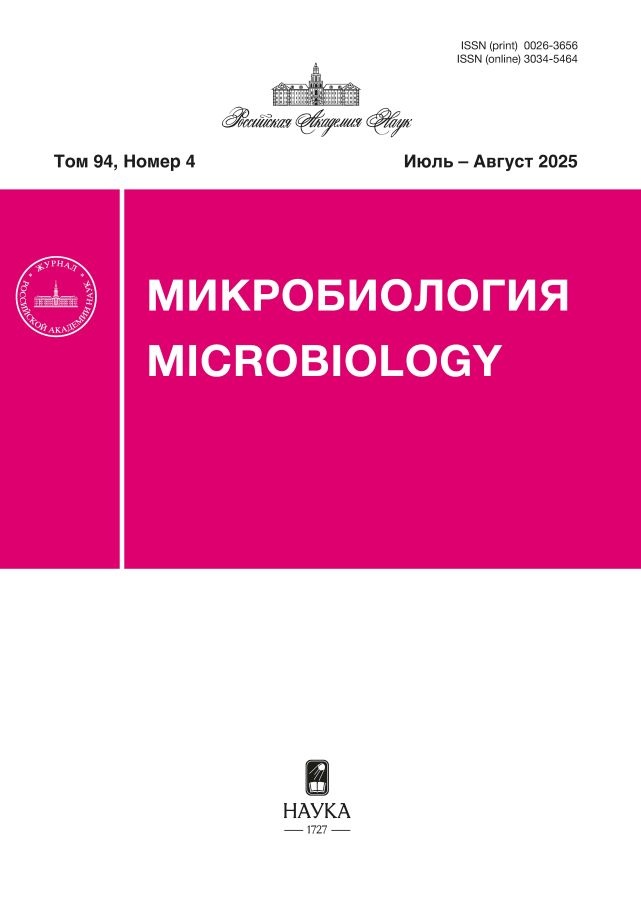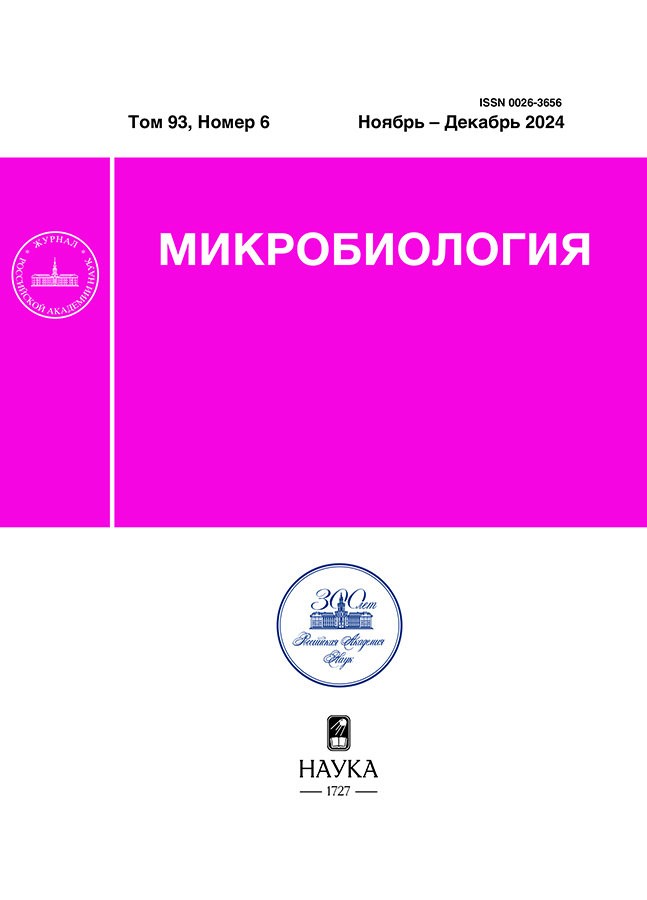Новые штаммы Bacillus thuringiensis subsp. israelensis, высокотоксичные для Aedes aegypti и Culex pipiens pipiens
- Авторы: Ходырев В.П.1, Поленогова О.В.1, Артемченко А.С.1, Кривопалов А.В.1, Глупов В.В.1
-
Учреждения:
- Институт систематики и экологии животных СО РАН
- Выпуск: Том 93, № 6 (2024)
- Страницы: 870-878
- Раздел: ЭКСПЕРИМЕНТАЛЬНЫЕ СТАТЬИ
- URL: https://jdigitaldiagnostics.com/0026-3656/article/view/655067
- DOI: https://doi.org/10.31857/S0026365624060161
- ID: 655067
Цитировать
Полный текст
Аннотация
Bacillus thuringiensis subsp. israelensis (Bti) ‒ наиболее известный подвид кристаллобразующих энтомопатогенных бактерий, используемых для контроля численности кровососущих комаров. В данной работе нами были изолированы три штамма Bti 4369, 4929 и 4999 из кишечников природной популяции личинок кровососущих комаров Aedes flavescens. Идентификация бактериальных изолятов по гену 16S rRNA и определение серотипа выявили принадлежность штаммов к Bt subsp. israelensis H14. Штаммы имели различия в морфологии бактериальных колоний, ряда биохимических характеристик и профилей белковых эндотоксинов. Выделенные штаммы Bti 4369 и 4999 показали высокую инсектицидную активность в отношении личинок Culex pipiens pipiens и Aedes aegypti, значения LC50 которых через 24 ч после воздействия составили 1.47‒2.26 × 108 спор/мл. Для штамма Bti 4929 LC50 составило 32.7‒35.9 × 108 спор/мл. Выделенные штаммы Bacillus thuringiensis subsp. israelensis имеют высокий потенциал для создания биопрепаратов для контроля численности кровососущих комаров.
Полный текст
Об авторах
В. П. Ходырев
Институт систематики и экологии животных СО РАН
Email: ovp0408@yandex.ru
Россия, Новосибирск, 630091
О. В. Поленогова
Институт систематики и экологии животных СО РАН
Автор, ответственный за переписку.
Email: ovp0408@yandex.ru
Россия, Новосибирск, 630091
А. С. Артемченко
Институт систематики и экологии животных СО РАН
Email: ovp0408@yandex.ru
Россия, Новосибирск, 630091
А. В. Кривопалов
Институт систематики и экологии животных СО РАН
Email: ovp0408@yandex.ru
Россия, Новосибирск, 630091
В. В. Глупов
Институт систематики и экологии животных СО РАН
Email: ovp0408@yandex.ru
Россия, Новосибирск, 630091
Список литературы
- Гаджиева С. С. Филогенетическая структура и состав фауны кровососущих комаров ( Diptera , Culicidae ) Северного Кавказа и факторы, определяющие их динамику // Известия ДГПУ. Естественные и точные науки. 2021. Т. 15. № 1. С. 27–32. https://doi.org/10.31161/1995-0675-2021-15-1-27-32
- Мирзаева А. Г., Смирнова Ю. А., Юрченко Ю. А., Кононова Ю. А. К познанию фауны и экологии кровососущих комаров ( Diptera , Culicidae ) лесостепных и степных районов Западной Сибири // Паразитология. 2007. Т. 41. № 4. С. 253‒267.
- Халин А. В., Айбулатов С. В., Филоненко И. В. Распространение кровососущих комаров ( Diptera , Culicidae ) на северо-западе России: виды рода Aedes meigen // Энтомол. обозр. 2021. T. 100. С. 755‒796. https://doi.org/10.31857/S0367144521040055
- Baig D. N., Mehnaz S. Determination, and distribution of cry-type genes in halophilc Bacillus thuringiensis isolates of Arabian Sea sedimentary rocks // Microbiol. Res. 2010. V. 165. P. 376–383. https://doi.org/10.1016/j.micres.2009.08.003
- Becker N. Ice granules containing endotoxins of microbial agents for the control of mosquito larvae ‒ a new application technique // J. Am. Mosq. Control Assoc. 2003. V. 19. P. 63–66.
- Ben-Dov E., Zaritsky A., Dahan E., Barak Z., Sinai R., Manasherob R., Khamraev A., Troitskaya E., Dubitsky A., Berezina N., Margalith Y. Extended screening by PCR for seven cry-group genes from field-collected strains of Bacillus thuringiensis // Appl. Environ. Microbiol. 1997. V. 63. P. 4883–4890. https://doi.org/10.1128/aem.63.12.4883-4890.1997
- Ben-Dov E. Bacillus thuringiensis subsp. israelensis and its dipteran-specific toxins // Toxins. 2014. V. 6. P. 222–1243. https://doi.org/10.3390/toxins6041222
- Bravo A., Gill S. S., Soberón M. Mode of action of Bacillus thuringiensis toxins and their potential for insect control // Toxicon. 2007. V. 49. P. 423–435. https://doi.org/10.1016/j.toxicon.2006.11.022
- Bravo A., Likitvivatanavong S., Gill S. S., Soberón M. Bacillus thuringiensis : a story of a successful bioinsecticide // Insect Biochem. Mol. Biol. 2011. V. 41. P. 423–431. https://doi.org/10.1016/j.ibmb.2011.02.006
- Canton P. E., Reyes E. Z., de Escudero I. R., Bravo A., Soberon M. Binding of Bacillus thuringiensis subsp. israelensis Cry4Ba to Cyt1Aa has an important role in synergism // Peptides. 2011. V. 32. P. 595–600.
- Chertkova E., Kabilov M. R., Yaroslavtseva O., Polenogova O., Kosman E., Sidorenko D., Alikina T., Noskov Y., Krivopalov A., Glupov V. V., Kryukov V.Yu. Links between soil bacteriobiomes and fungistasis toward fungi infecting the colorado potato beetle // Microorganisms. 2023. V. 11. Art. 943. https://doi.org/10.3390/microorganisms11040943
- Crickmore N., Bone E. J., Willians J. A., Ellar D. J. Contribution of the individual components of the δ-endotoxin crystal to the mosquitocidal activity of Bacillus thuringiensis subsp. israelensis // FEMS Microbiol. Lett. 1995. V. 131. P. 249–254.
- De Barjac H., Bonnefoi A. Essai de classification biochimique et sérologique de 24 souches de Bacillus de type B. thuringiensis // Entomophaga. 1962. V. 1. P. 5–31.
- De Barjac H., Bonnefoi A. Mise au point sur la classification des Bacillus thuringiensis // Entomophaga. 1973. V. 18. P. 5–17.
- De Maagd R. A., Bravo A., Crickmore N. How Bacillus thuringiensis has evolved specific toxins to colonize the insect world // Trends Genet. 2001. V. 17. P. 193–199. https://doi.org/10.1016/S0168-9525(01)02237-5
- De Maagd R. A., Bravo A., Berry C., Crickmore N., Schnepf H. E. Structure, diversity, and evolution of protein toxins from spore-forming entomopathogenic bacteria // Annu. Rev. Genet. 2003. V. 37. P. 409–433. https://doi.org/10.1146/annurev.genet.37.110801.143042
- Federici B. A., Lüthy P., Ibarra J. E. Parasporal body of Bacillus thuringiensis israelensis : structure, protein composition, and toxicity // Bacterial control of mosquitoes & black flies. Biochemistry, genetics & applications of Bacillus thuringiensis israelensis and Bacillus sphaericus / Eds. H. de Barjac, D.J. Sutherland. London, UK: Unwin Hyman, 1990. P. 16–44.
- Federici B. A., Park H.-W., Sakano Y. Insecticidal Protein Crystals of Bacillus thuringiensis // Inclusions in Prokaryotes/ Ed. Shively J. M. Springer-Verlag, Berlin, Heidelberg, 2006. Р. 195-235. https://doi.org/10.1007/3-540-33774-1_8
- Fernández-Chapa D., Ramírez-Villalobos J., Galán-Wong L. Toxic potential of Bacillus thuringiensis : an overview. Protecting rice grains in the post-genomic era. IntechOpen, 2019. https://doi.org/10.5772/intechopen.85756
- González-Villarreal S.E., García-Montelongo M., Ibarra J. E. Insecticidal activity of a Cry1Ca toxin of Bacillus thuringiensis Berliner ( Firmicutes : Bacillaceae ) and its synergism with the Cyt1Aa toxin against Aedes aegypti ( Diptera : Culicidae ) // J. Med. Entomol. 2020. V. 57. P. 1852–1856.
- Höfte H., Whiteley H. R. Insecticidal crystal proteins of Bacillus thuringiensis // Microbiol. Rev. 1989. V. 53. P. 242–255. https://doi.org/10.1128/mr.53.2.242-255.1989
- Ibarra J. E., del Rincón M. C., Ordúz S., Noriega D., Benintende G., Monnerat R., Regis L., de Oliveira C. M., Lanz H., Rodriguez M. H., Sánchez J., Peña G., Bravo A. Diversity of Bacillus thuringiensis strains from Latin America with insecticidal activity against different mosquito species / / Appl. Environ. Microbiol. 2003. V. 69. P. 5269–5274. https://doi.org/10.1128/AEM.69.9.5269-5274
- Ishii T., Ohba M. The 23-kilodalton CytB protein is solely responsible for mosquito larvicidal activity of Bacillus thuringiensis serovar kyushuensis // Curr. Microbiol. 1994. V. 29. P. 91–94. https://doi.org/10.1007/BF01575754
- García-Suárez R., Verduzco-Rosas L. A, Ibarra J. E. Isolation and characterization of two highly insecticidal, endophytic strains of Bacillus thuringiensis // FEMS Microbiol. Ecol. 2021. V. 97. Art. fiab080. https://doi.org/10.1093/femsec/fiab080
- Kumar P., Kamle M., Borah R., Kumar D. K., Sharma B. Bacillus thuringiensis as microbial biopesticide: uses and application for sustainable agriculture // Egypt. J. Biol. Pest Control. 2021. V. 31. Art. 95. https://doi.org/10.1186/s41938-021-00440-3
- Lai L., Villanueva M., Muruzabal-Galarza A., Fernández A. B., Unzue A., Toledo-Arana A., Caballero P., Caballero C. J. Bacillus thuringiensis Cyt proteins as enablers of activity of Cry and Tpp toxins against Aedes albopictus // Toxins. 2023. V. 15. Art. 211. https://doi.org/10.3390/toxins15030211
- Laemmli U. K. Cleavage of structural proteins during the assembly of the head of bacteriophage // Nature. 1970. V. 227. P. 680–685.
- Liu H. M., Yang P. P., Cheng P., Wang H. F., Liu L. J., Huang X., Zhao Y. Q., Wang H. W., Zhang C. X., Gong M. Q. Resistance level of mosquito species ( Diptera : Culicidae ) from Shandong Province, China // Int. J. Insect Sci. 2015. V. 7. P. 47–52. https://doi.org/10.4137/IJIS.S24232
- Ma X., Hu J., Ding C., Portieles R., Xu H., Gao J., Du L., Gao X., Yue Q., Zhao L., Borrás-Hidalgo O. New native Bacillus thuringiensis strains induce high insecticidal action against Culex pipiens pallens larvae and adults // BMC Microbiol. 2023. V. 23. P. 100. https://doi.org/10.1186/s12866-023-02842-9
- Manasherob R., Itsko M., Sela-Baranes N., Ben-Dov E., Berry C., Cohen S., Zaritsky A. Cyt1 Ca from Bacillus thuringiensis subsp. israelensis : production in Escherichia coli and comparison of its biological activities with those of other Cyt-like proteins // Microbiology (Reading). 2006. V. 152. P. 2651–2659.
- McClintock J.T., Schaffer C. R., Sjoblad R. D. A comparative review of the mammalian toxicity of Bacillus thuringiensis -based pesticides // Pestic. Sci. 1995. V. 45. P. 95–105.
- Mishra P. K., Bisht S. C., Ruwari P., Subbanna A. R.N.S., Bisht K., Bhatt J., Gupta H. S. Genetic diversity and functional characterization of endophytic Bacillus thuringiensis isolates from the North Western Indian Himalayas // Ann. Microbiol. 2017. V. 67. P. 143–155. https://doi.org/10.1007/s13213-016-1244-0
- Onen H., Luzala M. M., Kigozi S., Sikumbili R. M., Muanga C.-J.K., Zola E. N., Wendji S. N., Buya A. B., Bal ciunaitiene A., Viškelis J., Kaddumukasa M. A., Memvanga P. B. Mosquito-borne diseases and their control strategies: an overview focused on green synthesized plant-based metallic nanoparticles // Insects. 2023. V. 14. Art. 221. https://doi.org/10.3390/insects14030221
- Orduz S., Diaz T., Restrepo N., Patiño M. M., Tamayo M. C. Biochemical, immunological and toxicological characteristics of the crystal proteins of Bacillus thuringiensis subsp. medellin // Mem. Inst. Oswaldo Cruz. 1996. V. 91. P. 231–237. https://doi.org/10.1590/S0074-02761996000200020
- Pérez C., Fernandez L. E., Sun J., Folch J. L., Gill S. S., Soberón M., Bravo A. Bacillus thuringiensis subsp. israelensis Cyt1Aa synergizes Cry11Aa toxin by functioning as a membrane-bound receptor // Proc. Nat. Acad. Sci. USA. 2005. V. 102. P. 18303‒18308.
- Raymond B., Johnston P. R., Nielsen-LeRoux C., Lereclus D., Crickmore N. Bacillus thuringiensis : An impotent pathogen? // Trends Microbiol. 2010. V. 18. P. 189–194. https://doi.org/10.1016/j.tim.2010.02.006
- Reyes-Ramirez A., Ibarra J. E. Fingerprinting of Bacillus thuringiensis type strains and isolates by using Bacillus cereus group specific repetitive extragenic palindromic sequence-based PCR analysis // Appl. Environ. Microbiol. 2005. V. 71. P. 1346–1355. https://doi.org/10.1128/AEM.71.3.1346-1355.2005
- Schnepf E., Crickmore N., Van Rie J., Lereclus D., Baum J., Feitelson J., Zeigler D. R., Dean D. H. Bacillus thuringiensis and its pesticidal crystal proteins // Microbiol. Mol. Biol. Rev. 1998. V. 62. P. 775–806. https://doi.org/10.1128/MMBR.62.3.775-806.1998
- Shishir A., Roy A., Islam N., Rahman A., Khan S. N., Hoq M. M. Abundance, and diversity of Bacillus thuringiensis in Bangladesh and their cry genes profile // Front. Environ. Sci. 2014. V. 2. Art. 20. https://doi.org/0.3389/fenvs.2014.00020
- Soares-da-Silva J., Queirós S. G., de Aguiar J. S., Viana J. L., Neta M. D.R.A.V., da Silva M. C., Pinheiro V. C.S., Polanczyk R. A., Carvalho-Zilse G.A., Tadei W. P. Molecular characterization of the gene profile of Bacillus thuringiensis Berliner isolated from brazilian ecosystems and showing pathogenic activity against mosquito larvae of medical importance // Acta Trop. 2017. V. 176. P. 197–205. https://doi.org/10.1016/j.actatropica.2017.08.006
- Sur B., Nigam N., Joshi A. K., Bihari V. Characterization of mosquito larvicidal Bacillus thuringiensis isolated from soils of India // Indian J. Biotechnol. 2003. V. 2. P. 268–270.
- Valtierra-de-Luis D., Villanueva M., Lai L., Williams T., Caballero P. Potential of Cry10Aa and Cyt2Ba, two minority δ-endotoxins produced by Bacillus thuringiensis ser. israelensis , for the control of Aedes aegypti larvae // Toxins. 2020. V. 12. Art. 355.
- Van Frankenhuyzen K . Cross-order and cross-phylum activity of Bacillus thuringiensis pesticidal proteins // J. Invert. Pathol. 2013. V. 114. P. 76–85. https://doi.org/10.1016/j.jip.2013.05.010
- Yan M., Roehrl M. H., Wang J. Y. Discovery of crystalline inclusions in Bacillus licheniformis that resemble parasporal crystals of Bacillus thuringiensis // Can. J. Microbiol. 2007. V. 53. P. 1111‒1115. https://doi.org/10.1139/W07-076
- Weisburg W. G., Barns S. M., Pelletier D. A., Lane D. J. 16s ribosomal DNA amplification for phylogenetic study // J. Bacteriol. 1991. V. 173. P. 697–703.
- Wu D., Cheng F. N. Synergism in mosquitocidal activity of 26 and 65 kDa proteins from Bacillus thuringiensis subsp. israelensis crystal // FEBS Lett. 1985. V. 190. P. 232–236. https://doi.org/10.1016/0014-5793(85)81290-4
Дополнительные файлы














